Effective Strategies for Treating Yards Against Flies


Understanding the Pest
Flies are more than just a nuisance in our yards. Understanding their behavior and characteristics lays the foundation for effective management strategies. To achieve a successful control plan, it is essential to delve into fly identification and their life cycle.
Identification
Identifying the type of fly is crucial, as different species respond to control methods in varied ways. Common species include the house fly (Musca domestica), fruit fly (Drosophila melanogaster), and horse fly (Tabanus spp.). Each has distinct habits and preferred habitats. House flies, for instance, thrive in warm environments and are attracted to food waste, while fruit flies prefer overripe fruits and sugary liquids. Knowing the specific species allows for tailored control measures.
Life Cycle
Flies reproduce rapidly. Their life cycle has four stages: egg, larva, pupa, and adult. The entire cycle may take as little as one week, depending on environmental conditions. Adult female flies lay hundreds of eggs, often in decaying organic matter or food sources. Recognizing this cycle helps in estimating fly populations and determining when and where to implement control measures.
"Understanding the life cycle of flies aids homeowners in predicting and managing population surges."
Pest Prevention Strategies
Prevention is an efficient approach to managing fly populations. Implementing a combination of environment modification and physical barriers can significantly reduce the likelihood of infestations.
Environment Modification
Modifying the environment to make it less conducive for flies can yield effective results. Key strategies include:
- Cleaning Up: Regularly clean outdoor areas to remove waste. This includes pet droppings, food scraps, and decomposing vegetation, as these attract flies.
- Proper Waste Management: Store trash in covered bins and ensure it's emptied frequently.
- Drainage Solutions: Eliminate standing water, as it provides breeding grounds.
Physical Barriers
Physical barriers serve as a direct deterrent against flies. Some effective options include:
- Screens for Windows and Doors: This prevents flies from entering indoor spaces.
- Fly Traps: Use commercially available fly traps that attract and contain flies, reducing their numbers in the yard.
- Natural Barriers: Planting certain herbs or flowers can also deter flies. Citronella and basil are known for their repellent properties.
Control Methods
Despite the best prevention efforts, control methods may still be necessary. These can be divided into chemical control and biological control.
Chemical Control
Chemical insecticides can provide immediate relief from fly populations but should be used judiciously. Here are a few considerations:
- Targeted Application: Use products specifically formulated for flies to maximize effectiveness.
- Follow Labels: It is crucial to follow application guidelines to minimize risks to beneficial insects and the ecosystem.
- Timing: Applying insecticides during peak activity times can significantly improve control success.
Biological Control
Biological control methods utilize natural enemies of flies to reduce their populations. Beneficial insects like predatory wasps can be introduced to manage fly larvae. Additionally, keeping a balanced ecosystem in the yard promotes beneficial insects that can help manage pests naturally. This approach aligns with sustainable practices and is less harmful to the environment.
Incorporating these strategies can create a formidable defense against fly infestations, equipping homeowners with effective tools for yard management.
Foreword to Fly Management
Managing flies effectively is an important aspect of maintaining a pleasant and hygienic yard environment. Flies not only pose a nuisance but can also carry diseases, making their presence a significant concern for homeowners. Understanding how to manage flies is essential for several reasons. It can help protect the integrity of your outdoor space, enhance your quality of life, and even safeguard the health of your family and pets.
Effective fly management begins with a thorough understanding of fly behavior and biology. By grasping the specifics of their life cycles, environments, and attractants, homeowners can devise informed strategies to control fly populations. This knowledge serves as a foundation for implementing practical measures that reduce the likelihood of fly infestations.
One critical consideration in fly management is the prevention aspect. Rather than simply reacting to fly presence, proactive measures can help minimize their attraction to your yard. Regular maintenance, waste management, and proper landscaping are vital components that contribute to an environment less hospitable to flies.
The benefits of effective fly management extend beyond mere comfort. By reducing fly populations, homeowners can also contribute to a healthier ecosystem. Flies are known to breed in unsanitary conditions, and managing these factors can lead to a more balanced outdoor environment. This is particularly crucial in residential areas, where interactions between people, pets, and wildlife can potentially create complex ecological dynamics.
In summary, fly management is more than just eliminating flies; it involves creating a sustainable approach that considers the ecological context while addressing practical concerns. By focusing on prevention, understanding behavioral patterns, and making informed choices, homeowners can effectively treat their yards against these persistent pests.
Understanding Fly Behavior
Understanding fly behavior is essential for effective fly management in residential yards. Recognizing how flies reproduce, feed, and interact with their environment allows homeowners to implement appropriate measures. This understanding aids in pinpointing the conditions that attract these pests, thus enabling the development of targeted strategies to minimize their presence. Furthermore, being informed about specific fly species and their distinct habits can lead to more effective treatment options. A comprehensive grasp of fly behavior emphasizes prevention over reaction, which is key in managing fly populations sustainably.
Common Species of Flies
House Flies
House flies are perhaps the most ubiquitous pests found in human habitats. Their habit of breeding in decaying organic matter makes them a primary concern for households. House flies are known for their rapid reproductive capabilities and can multiply into dense populations very quickly. An important characteristic of house flies is their ability to transport pathogens from one place to another, making them a vector for diseases. Their adaptability is a unique feature that signifies their success in urban environments. Controlling house flies effectively is crucial since they can lead to health risks if not addressed.
Fruit Flies
Fruit flies are small but can become a significant annoyance, particularly in kitchens and gardens where fruits are present. Their attraction to ripe or fermenting fruits highlights a specific aspect of their behavior; they primarily feed on sugar-rich materials. This preference significantly contributes to their role in domestic pest management. The unique feature of fruit flies is their swift lifecycle, allowing them to flourish rapidly under optimal conditions. Understanding their habits can help one take preventative measures, reducing the likelihood of infestations before they start.
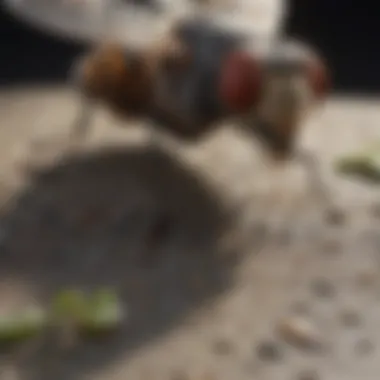
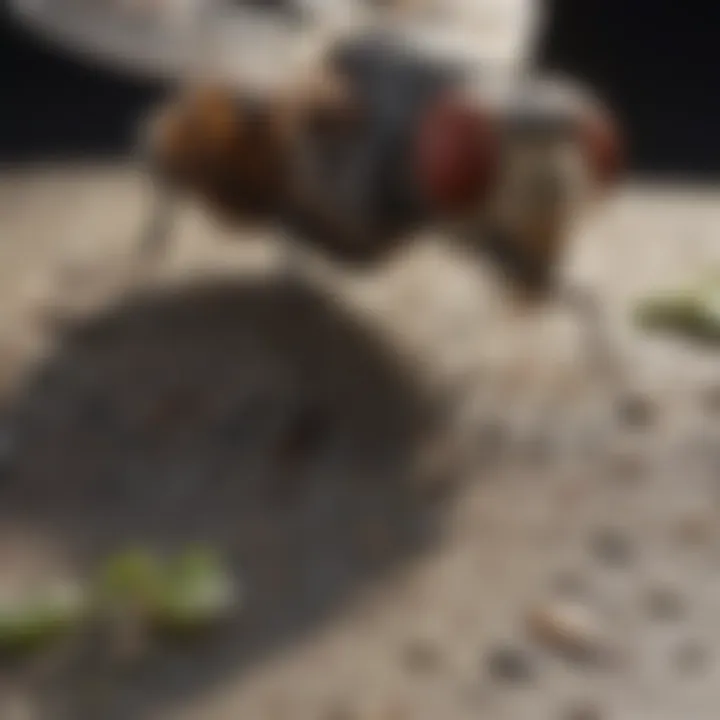
Stable Flies
Stable flies, similar in appearance to house flies, primarily infest livestock and present a challenge in agricultural settings. Their key characteristic is their biting behavior, which can cause distress in animals, making their control critical for farm management. The ability of stable flies to breed in manure adds another layer to their management. In residential areas near farms, they can invade yards, thus understanding their breeding preferences is vital for effective treatment.
Flesh Flies
Flesh flies are distinct due to their reproductive strategies. They often lay their eggs on decaying meat or carrion, hence their association with decomposing organic material. A significant aspect of flesh flies is their habit of developing rapidly, which can lead to explosive population outbreaks. Their ability to thrive in environments with poor sanitation highlights the importance of proper waste disposal. Addressing issues surrounding flesh flies involves understanding their breeding preferences, which guide the necessary steps to keep them at bay in the yard.
Habitat Preferences
Breeding Sites
Breeding sites play a crucial role in fly population dynamics. Flies prefer locations that offer warmth and moisture. For instance, decomposing organic matter often serves as an ideal site for flies to lay eggs. Awareness of these sites can help homeowners take proactive measures. In this context, the ability to identify and eliminate breeding grounds can significantly reduce fly numbers. The unique feature of these sites lies in their potential for rapid population increases, emphasizing the need for consistent monitoring and management.
Feeding Patterns
Feeding patterns provide insight into what attracts flies to specific areas. Flies often gravitate towards food waste, pet food, and fruits left unattended. Understanding these patterns allows homeowners to modify their disposal habits and thus discourage flies from frequenting their yard. By recognizing the unique feeding preferences of different fly species, one can address these needs effectively, making environmental adjustments that deter their presence. This knowledge is beneficial for maintaining a clean and healthy outdoor space.
Seasonal Variations
Seasonal variations influence fly populations significantly. Flies tend to thrive in warmer months, and understanding these patterns is key to managing infestations. Each season brings about changes in breeding habits and feeding opportunities. Recognizing the unique features of seasonal behaviors can guide homeowners in implementing timely preventive measures. For instance, knowing that flies may seek warmth in homes during colder times can lead to proactive steps in sealing entry points. Ultimately, awareness of these variations helps maintain a consistent strategy against infestations.
Identifying Attractants in Your Yard
Understanding the key elements that attract flies to your yard is essential for effective management. Every homeowner faces challenges with fly populations, especially during warmer seasons. Identifying these attractants can significantly reduce fly presence. By pinpointing the sources that lure flies, you can take measures to eliminate or control them. The benefits are clear: a clean and pleasant outdoor space, reduced annoyance from flies, and a healthier environment.
Food Sources
Compost Bins
Compost bins are a common attractant for flies because they can produce odors that simulate food decay. The decomposition process creates a perfect habitat for flies to thrive. Flies are attracted to the moisture and organic material present. However, using compost bins wisely can also be beneficial. They turn waste into soil conditioner. It is crucial to ensure that compost does not become too wet or contain food scraps that emit strong odors. Otherwise, they can become fly breeding grounds. Regularly turning the compost can help to manage smell and deter flies.
Garbage Cans
Garbage cans are another major source of attraction. They often hold food waste that provides an easy meal for flies. Keeping garbage cans sealed is vitally important. A tightly closing lid prevents flies from entering. Choosing appropriate containers that do not leak is also advised. Frequent disposal schedules can minimize odors. Still, certain materials can attract flies more than others, and maintaining a clean environment near garbage cans is necessary to avoid infestations.
Pet Waste
Pet waste presents its own challenges. Left unattended, it generates foul odors that can easily draw flies. Proper disposal methods are essential. Using sealed bags for disposal can reduce the chance of attracting flies. Additionally, removing waste from the yard promptly is important. Training pets to use designated areas can also help. This not only keeps your yard clean but also limits fly access to nourishing material.
Breeding Grounds
Horse Manure
Horse manure is an ideal breeding ground for flies, especially in equestrian areas. It provides both food and protection for developing larvae. Flies can multiply rapidly when manure is left on the ground. Therefore, it is important to remove manure regularly. Ensuring proper composting of manure can also help reduce fly populations by creating a less hospitable environment. Horse owners must balance composting benefits with the need to manage flies effectively.
Standing Water
Standing water is another prime breeding site for flies, particularly for species like mosquitoes. Stagnant water allows flies to complete their lifecycle. Regularly checking for and draining any standing water is critical. This could be from clogged gutters or empty pots. In addition, installing proper drainage can effectively minimize these puddles. Keeping water features circulating can also help ward off breeding.
Decaying Organic Matter
Decaying organic matter, such as fallen fruit or dead plants, attracts flies due to its nutrient-rich content. These materials provide an excellent environment for fly larvae. Regular cleaning of fallen leaves and fruits can prevent flies from accessing this food source. It's also vital to ensure proper disposal of yard waste to minimize fly attraction. Composting practices should take care not to attract unwanted pests.
Environmental Conditions
Temperature Influences
Temperature greatly impacts fly populations. Flies prefer warmer temperatures, making yards during summer particularly affected. Keeping your yard shaded can help maintain lower temperatures. Additionally, using outdoor fans might deter flies. Recognizing temperature’s role can help homeowners anticipate fly activity levels and act accordingly.
Humidity Levels
Humidity influences fly populations as well. High humidity creates favorable conditions for flies to thrive. Ensuring proper air circulation can help manage humidity levels in the yard. Adjusting landscaping to include elements that encourage airflow can mitigate this problem. It is crucial, however, to monitor moisture in the garden, as excessive watering can create breeding opportunities.
Light Preferences
Flies are attracted to specific lighting conditions. Bright lights can draw flies during evenings. Installing yellow insect lights can help minimize this issue, as they are less attractive to flies than traditional bulbs. Aligning outdoor lighting strategies with knowledge of fly preferences can control their numbers effectively. Moreover, reducing unnecessary lighting can further deter these unwelcome guests.
By identifying attractants in your yard, you can significantly reduce the number of flies. Proper maintenance strategies will contribute to an efficient fly control approach.
Preventative Measures for Fly Control
Establishing a fly control strategy is essential for maintaining a pleasant and safe yard. Prevention is often easier and more cost-effective than trying to eliminate established fly populations. This section discusses several key elements that contribute to effective fly prevention. From regular yard maintenance to proper waste management, each measure serves as a barrier to fly infestations, reducing the likelihood of these pests becoming a nuisance.
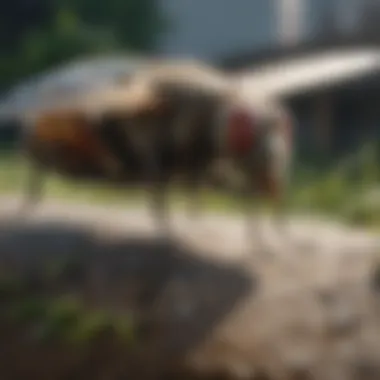

Yard Maintenance
Lawn Care
Lawn care plays a critical role in overall fly control efforts. A well-maintained lawn discourages flies from settling. Regular mowing and eliminating tall weeds can prevent flies from finding suitable breeding sites. The key characteristic of effective lawn care is maintaining grass at optimal height. Shorter grass allows for better sunlight penetration and airflow, which discourages the damp conditions that flies favor. One advantage of good lawn care is that it enhances the aesthetic appeal of the yard while simultaneously reducing the likelihood of a fly problem.
Gardening Practices
Gardening practices are essential in preventing flies, especially in areas where food plants are grown. Keeping gardens tidy, removing overripe fruits, and preventing standing water are vital considerations. The unique feature of proactive gardening is the ability to discourage flies by removing potential attractants. This prevents them from breeding nearby. Notably, gardens that are well-organized and consistently monitored require less intervention for pest control.
Regular Clean-Up
Regular clean-up of the yard is another foundational aspect of fly management. Clutter, leaves, or debris can trap moisture, creating ideal breeding sites for flies. The key characteristic of a clean yard is maintaining clear surfaces. Frequent raking and disposing of organic waste minimizes the chance of fly infestations. A drawback, however, might be the time investment required, but the benefits of maintaining a clean yard greatly outweigh this concern.
Proper Waste Management
Sealed Containers
Using sealed containers for garbage can significantly deter flies from entering. When food waste is kept securely, it reduces odors and prevents attraction to the area. The key characteristic of sealed containers is their ability to confine smells and block access to flies. This method is very beneficial as it minimizes problems before they start; however, the initial cost of durable containers could be a consideration for homeowners.
Frequent Disposal
Frequent disposal of trash is essential in controlling fly populations. Regularly removing waste ensures that flies do not have the opportunity to establish breeding sites. The main feature of this approach is the commitment to a schedule. By disposing of waste on a timely basis, one can significantly reduce the risk of fly infestations. Although this practice may require more effort, it proves to be worthwhile in keeping flying pests at bay.
Composting Best Practices
Composting can be a double-edged sword, as it can attract flies if not managed correctly. However, using best practices ensures compost piles do not become breeding grounds. The key characteristic here is maintaining a balanced compost mix of green and brown materials. Compost should be turned regularly to aerate it, discouraging odors and flies. While composting can enhance soil quality, improper management may lead to uninvited guests, so attention is paramount.
Physical Barriers
Screened Porches
Screened porches serve as a practical solution for keeping flies outside while enjoying outdoor spaces. Their main advantage is the physical barrier that prevents entry, allowing homeowners to use porches without concern. This is especially vital during warmer months when flies are abundant. However, the downside may include the installation costs and maintenance to keep screens intact.
Netting for Gardens
Netting for gardens is another effective method for fly prevention. It protects plants while allowing sunlight and rain through, which is essential for healthy growth. The key feature of netting is its ability to create a barrier against pests without obstructing air circulation or light. One downside is that netting must be applied carefully to avoid damage during seasonal changes.
Outdoor Misting Systems
Outdoor misting systems provide a more automated solution for fly control. They release insecticides in a fine mist, which can target flies effectively. The main benefit of such systems is the reduction of manual application efforts. They are popular for larger yards that often need assistance with ongoing pest issues. However, consideration must be given to the safety and environmental impact of chemicals used, making it important to choose system design wisely.
"Preventative measures can save time and resources in the long run, making them pivotal for effective fly management."
By integrating these preventative measures, homeowners can create a yard that is less hospitable to flies, thus enhancing overall quality of life.
Effective Treatment Methods
Effective treatment methods play a crucial role in managing fly populations in residential yards. These methods often provide immediate results and can significantly reduce annoyance caused by flies. Understanding various treatment techniques allows homeowners to select the most suitable option for their specific needs. The right approach may vary based on individual yard conditions, the types of flies present, and personal preferences regarding chemical use. Most importantly, effective treatment methods can lead to a healthier outdoor environment, promoting enjoyment of your yard.
Trapping Techniques
Commercial Fly Traps
Commercial fly traps are widely available and designed specifically to attract and capture flies. Their contribution is notable, as they offer efficient mechanisms for reducing fly populations without requiring homeowners to create their own traps. One key characteristic of commercial fly traps is their specialized attractants, which often mimic food sources that entice flies. Due to their ready-made nature, they are a beneficial choice for those seeking quick solutions. However, it is essential to consider that not all commercial traps are equally effective against every fly species.
"Commercial fly traps offer convenience, often yielding immediate results in busy households."
Many commercial traps also feature unique designs that enhance catch rates. They may use visual cues or pheromones, significantly increasing their effectiveness. On the downside, some traps may require periodic replacement, which can incur additional costs over time.
DIY Traps
DIY traps provide another avenue for fly control. They empower homeowners to utilize household items for effective trapping, which may be appealing for those interested in eco-friendly methods. A notable feature of DIY traps is their simplicity and cost-effectiveness. Common examples include using a jar with a vinegar-soaked cloth, which can attract and capture flies.
This homemade approach is beneficial as it promotes resourcefulness and can be customized to suit specific situations. Yet, DIY traps may not always be as effective as commercial ones, especially regarding larger fly infestations.
Placement Strategies
Placement strategies significantly influence the success of fly traps. Proper positioning ensures that traps are located where flies are most active and numerous. The key characteristic here is the strategic selection of sites. Placing traps near breeding areas or food sources can dramatically enhance their performance. This approach is beneficial because it allows homeowners to maximize trap efficiency without more invasive treatments.
However, there are some disadvantages. Some homeowners may overlook the need for regular monitoring and maintenance of trap locations, which can lead to decreased effectiveness over time.
Chemical Treatments
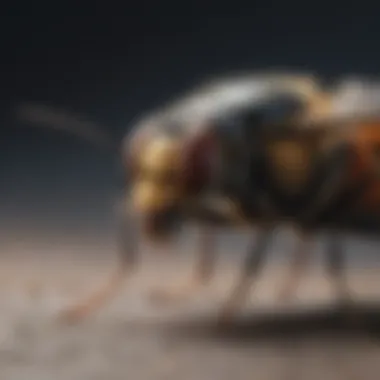
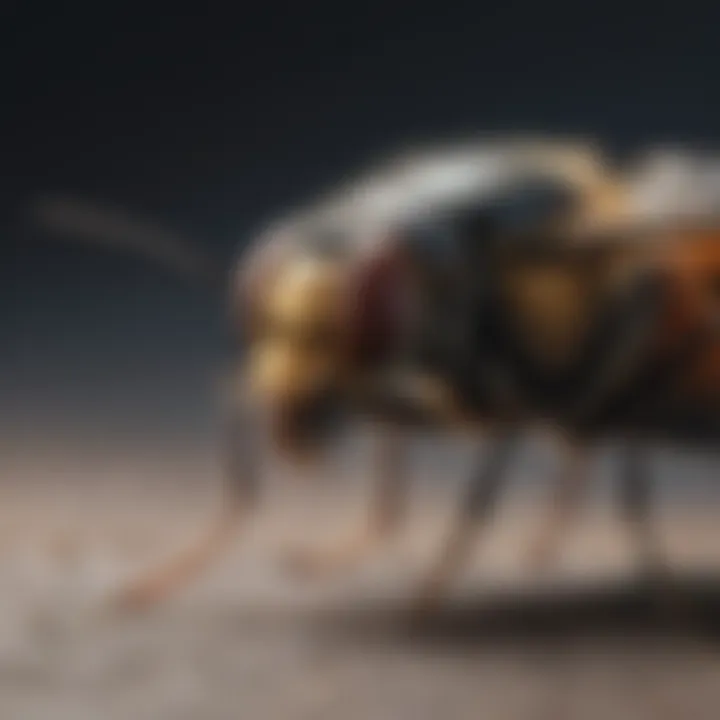
Understanding Insecticides
Understanding insecticides is essential for those considering chemical treatments for fly control. These products can provide immediate results and are often the choice when dealing with severe infestations. The key characteristic of insecticides is their active ingredients, which are designed to eliminate pests. Many homeowners find them beneficial due to their effectiveness when applied correctly.
Nonetheless, there are unique features related to the environmental impacts and potential harm to beneficial insects. The use of insecticides requires careful consideration of risks and benefits, as improper use can lead to negative consequences in the ecosystem.
Application Methods
Application methods refer to the ways insecticides can be effectively applied in a yard. Different methods, such as spraying or using granules, cater to various yard layouts and infestation levels. The key characteristic of these methods is their versatility. Homeowners can select methods based on individual circumstances, whether that is applying directly to plants or treating specific areas where flies breed. This flexibility is beneficial because it allows for targeted action against infestations.
However, it’s crucial to follow guidelines for safe application. Improper techniques can lead to ineffective treatments and unnecessary harm to surrounding plants and wildlife.
Safety Considerations
Safety considerations are fundamental when it comes to chemical treatments. Homeowners must take care to minimize risks associated with insecticide use. The primary concern is potential exposure to children, pets, and beneficial organisms in the area. Choosing products with fewer side effects can be a wise choice. Additionally, understanding application intervals can help maintain a safe environment.
On the flip side, the necessity for caution can complicate the treatment process. Homeowners may need additional time and effort to ensure safety during and after treatment.
Natural Remedies
Essential Oils
Essential oils have gained recognition as effective natural remedies for repelling flies. Among the benefits, their attractive scents can help deter pests while offering a pleasant aroma in the yard. The key characteristic of essential oils lies in their composition, which includes various plant extracts known for their insect-repelling properties. Homeowners often find them appealing due to their nontoxic nature, providing a safer option for families and pets.
However, the unique feature to note is that while essential oils can work well for minor infestations, they might not be effective against heavy fly populations.
Herbal Approaches
Herbal approaches also serve as effective means of fly management in yards. Certain herbs, like basil and mint, can act as natural repellents when planted strategically. The key characteristic of herbal approaches is their dual function: they enhance garden aesthetics while serving as pest deterrents. This adaptability makes them a popular choice for garden lovers.
Yet, one disadvantage is that these plants may take time to establish and reach effective levels of pest control. Homeowners will have to be patient and proactive in maintaining their herbs.
Beneficial Insects
Beneficial insects, such as spiders and predatory wasps, can serve as natural controls for fly populations. Their presence encourages a balanced ecosystem, promoting ongoing pest management. The key characteristic to highlight is their role as predators. Homeowners benefit not only from fly control but also from a healthier garden environment.
However, a unique consideration is the variability in effectiveness. The presence of beneficial insects can depend on local conditions and habitat quality, which may influence the overall success rate in managing fly populations within a yard.
Monitoring Fly Populations
Monitoring fly populations is crucial for effective fly management strategies in residential yards. By observing fly activity and behaviors, homeowners can identify peak times of infestation and the specific attractants at play. This insight allows for targeted interventions, increasing the likelihood of achieving sustainable control over fly numbers. Regular monitoring also facilitates an understanding of the effectiveness of various treatments over time.
Tracking Fly Activity
Observation Techniques
Observation techniques serve as a foundational aspect of tracking fly activity. This method involves visually assessing fly presence in different areas throughout the yard. Homeowners can identify patterns in fly behavior, noting where infestations are most prevalent. One key characteristic of this method is its simplicity, making it accessible to most people. Observation does not require any specialized tools, which helps maintain low costs.
The downside may be that it requires patience and consistency to yield meaningful data. Additionally, it may not provide a comprehensive picture of fly activity, making it necessary to combine with other methods for better accuracy.
Data Collection Methods
Data collection methods enhance the ability to monitor fly populations systematically. These methods involve recording fly counts and habits consistently. A common approach is keeping a log of observations regarding the times and locations of fly activities. This method is beneficial because it allows for more structured information gathering, which can be analyzed over time for patterns. A unique feature of data collection is its potential for more detailed analysis, aiding homeowners in understanding long-term trends in fly populations. However, maintaining an accurate log can be time-consuming and requires diligence.
Identifying Trends
Identifying trends is a pivotal element of monitoring fly populations. This process involves analyzing collected data to detect patterns in fly activity over time. Observing trends helps in predicting future infestations, contributing greatly to proactive management strategies. A significant benefit of this approach is its ability to inform homeowners on the effective timing of various treatments. The unique feature of trend identification is its focus on establishing a historical context for fly populations. This method can sometimes overlook sudden changes not reflected in long-term data, requiring an adaptable management approach.
Evaluating Treatment Effectiveness
Assessing Changes in Numbers
Assessing changes in numbers provides critical data regarding the effectiveness of implemented treatments. Homeowners record fluctuations in fly populations over time, which allows them to evaluate which techniques yield the most success. A key characteristic of this method is that it is straightforward, requiring only periodic counts. This simplicity makes it a popular choice among homeowners. However, frequent assessments can turn into a chore, especially if changes are slower than anticipated.
Long-Term Strategies
Long-term strategies focus on sustainable management of fly populations. These strategies might include regular maintenance practices, habitat modification, and the introduction of natural predators. Their significance lies in reducing recurring issues, not just addressing immediate infestations. The unique advantage of long-term strategies is the cultivation of an ecosystem that is less conducive to fly breeding. That said, these strategies often take time to establish, and immediate results are not guaranteed.
Adjustments Based on Observations
Adjustments based on observations highlight the dynamic nature of fly management. This aspect involves modifying treatment approaches as new data from monitoring efforts become available. Homeowners might shift strategies based on real-time outcomes from previous methods. The main advantage of this flexibility is the ability to react swiftly to changing fly behaviors or environmental conditions, enhancing overall efficacy. However, over-adjusting based on limited observations can lead to inconsistent results, and therefore, a balanced approach is essential.
Ending
Understanding the key principles outlined throughout the article helps in creating targeted interventions. For instance, recognizing specific attractants such as organic waste or standing water enables better clean-up routines that diminish breeding opportunities. Thus, it improves the overall health and hygiene of our living spaces.
Moreover, employing a combination of physical barriers, natural remedies, and monitored trapping systems contributes to a balanced ecosystem. This is not only effective in reducing fly populations but also promotes ecological stability. Homeowners can enjoy outdoor spaces while minimizing the negative impact of flies on their living conditions.
"Sustainable management is not just about immediate results; it's a long-term commitment to yard health."
While these strategies may take time and effort, the benefits greatly outweigh the initial investment. A systematic approach can lead to happier outdoor living experiences, reduced dependence on chemical treatments, and the vitality of beneficial insects that serve ecological functions. Consider this as essential not only for personal comfort but also for environmental stewardship. A cleaner, fly-free yard translates to healthier living for our families and our communities.







